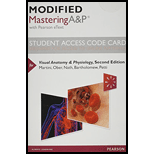
Vito has been experiencing persistent indigestion, heartburn, and loss of appetite. After many weeks of this discomfort, he finally schedules an appointment with his physician. The doctor performs a diagnostic procedure in which he passes a tube through Vito’s mouth into his stomach. Through this tube the doctor can use a scope to view the tissue lining Vito’s stomach. Upon examination, the doctor notices a tumor, or mass of abnormal cells, on the stomach wall. The doctor excises a small clump of tissue and sends it to the pathology laboratory for analysis. From what you have just learned about cells, answer the following questions about Vito’s condition.
Which word describing the tumor do Vito and his doctor hope to read in the lab report? Why? Which word do they not want to read in the report? Why?
Want to see the full answer?
Check out a sample textbook solution
Chapter 3 Solutions
Modified MasteringA&P with Pearson eText -- Standalone Access Card -- for Visual Anatomy & Physiology (2nd Edition)
- Fresh out of college, Maria has her first job teaching school. When she goes for a pre-employment chest X-ray required by the school district, the technician places a lead-lined apron over her abdomen but not over any other part of Marias body. The apron prevents electromagnetic radiation from penetrating into the protected body area. What cells is the lead shield designed to protect, and why?arrow_forwardWhy is cell furrowing important in cell division? If cytokinesis did not occur, what would be the end result?arrow_forwardWhy do most cancer treatments at present target microtubule formation of the cell? What are the most recent discoveries in terms of cancer treatment?arrow_forward
- In your opinion, was it unethical for researchers to take Henrietta Lacks' cells without her permission? Why or why not? Do you think it is unethical that biotech/pharmaceutical companies are currently profitting from Henrietta Lacks' cells? Why or why not?arrow_forwardIf you were to look at a sample of “normal” cells, what phase of the cell cycle do you think most of the cells would be in? If you were to look at a sample of cancer cells, what phase of the cell cycle do you think most of the cells would be in?arrow_forwardHow do stem cells lose their ability to differentiate into any cell type?arrow_forward
 Human Biology (MindTap Course List)BiologyISBN:9781305112100Author:Cecie Starr, Beverly McMillanPublisher:Cengage Learning
Human Biology (MindTap Course List)BiologyISBN:9781305112100Author:Cecie Starr, Beverly McMillanPublisher:Cengage Learning Human Heredity: Principles and Issues (MindTap Co...BiologyISBN:9781305251052Author:Michael CummingsPublisher:Cengage Learning
Human Heredity: Principles and Issues (MindTap Co...BiologyISBN:9781305251052Author:Michael CummingsPublisher:Cengage Learning Human Physiology: From Cells to Systems (MindTap ...BiologyISBN:9781285866932Author:Lauralee SherwoodPublisher:Cengage Learning
Human Physiology: From Cells to Systems (MindTap ...BiologyISBN:9781285866932Author:Lauralee SherwoodPublisher:Cengage Learning


